Variations in the Spatial Distribution of Smart Parcel Lockers in the Central Metropolitan Region of Tianjin, China: A Comparative Analysis before and after COVID-19
Abstract
1. Introduction
2. Materials and Methods
2.1. Study Area
2.2. Data Source
2.3. Methods
2.3.1. Kernel Density Estimation Method
2.3.2. Average Nearest Neighbor Analysis
2.3.3. Standard Deviational Ellipse
2.3.4. Geographical Detector
3. Results
3.1. Differences in the Quantitative Characteristics between Pre- and Post-Pandemic
3.2. Differences in the Spatial Agglomeration Characteristics between Pre- and Post-Pandemic
3.3. Differences in the Spatial Equilibrium Characteristics between Pre- and Post-Pandemic
3.4. Differences in the Influencing Factors between Pre- and Post-Pandemic
3.4.1. Factor Detection
3.4.2. Interaction Detection
4. Discussion
4.1. SPLs Application Scenearios
4.2. SPLs Layout Planning Issues
4.3. SPLs Dynamic Layout Planning
5. Conclusions
- (1)
- The COVID-19 pandemic has accelerated the emergence of SPLs, and the majority of SPLs clustered in residential communities.
- (2)
- The spatial distribution of SPLs experienced the process from random to agglomerated during the pre- and post-pandemic period, and the development trend of SPLs coincided with Tianjin’s urban development patterns.
- (3)
- During the three-year course, the total population remained one of the most influential factors, per capita income and building density became less influential, and most importantly, the influential power of residential community increased, which deserves more attention. The evolution of influencing factors demonstrates that the emphasis on SPLs layout has shifted from cost reduction and efficiency improvement to customer-orientation.
Author Contributions
Funding
Institutional Review Board Statement
Informed Consent Statement
Data Availability Statement
Acknowledgments
Conflicts of Interest
References
- Bhatti, A.; Akram, H.; Basit, H.M.; Khan, A.U.; Raza, S.M.; Naqvi, M.B. E-commerce trends during COVID-19 Pandemic. Int. J. Futur. Gener. Commun. 2020, 13, 1449–1452. [Google Scholar]
- Moon, J.; Choe, Y.; Song, H. Determinants of consumers’ online/offline shopping behaviours during the COVID-19 pandemic. Int. J. Environ. Res. Public Health 2021, 18, 1593. [Google Scholar] [CrossRef] [PubMed]
- Echegaray, F. What POST-COVID-19 lifestyles may look like? Identifying scenarios and their implications for sustainability. Sustain. Prod. Consump. 2021, 27, 567–574. [Google Scholar] [CrossRef] [PubMed]
- Kennett-Hensel, P.A.; Sneath, J.Z.; Lacey, R. Liminality and consumption in the aftermath of a natural disaster. J. Int. Consum. Mark. 2012, 29, 52–63. [Google Scholar] [CrossRef]
- Lee, S.M.; Lee, D. “Untact”: A new customer service strategy in the digital age. Serv. Bus. 2020, 14, 1–22. [Google Scholar] [CrossRef]
- Statista. Retail E-Commerce Sales Worldwide from 2014 to 2016. Available online: https://www.statista.com/statistics/379046/worldwide-retail-e-commerce-sales/ (accessed on 20 February 2023).
- Statista. E-Commerce in China–Statistics & Facts. Available online: https://www.statista.com/topics/1007/e-commerce-in-china/#topicOverview (accessed on 20 February 2023).
- National Bureau of Statistics of China. Statistics Bulletin of National Economic and Social Development of People’s Republic of China (PRC) in 2021. Available online: http://www.stats.gov.cn/tjsj/zxfb/202202/t20220227_1827960.html (accessed on 22 February 2023).
- Brown, J.R.; Guiffrida, A.L. Carbon emissions comparison of last mile delivery versus customer pickup. Int. J. Logist. Res. 2014, 17, 503–521. [Google Scholar] [CrossRef]
- Pani, A.; Mishra, S.; Golias, M.; Figliozzi, M. Evaluating public acceptance of autonomous delivery robots during COVID-19 pandemic. Transport. Res. D-Tr. E. 2020, 89, 102600. [Google Scholar] [CrossRef]
- Chen, C.; Demir, E.; Huang, Y.; Qiu, R. The adoption of self-driving delivery robots in last mile logistics. Transp. Res. E Logist. Transp. Rev. 2021, 146, 102214. [Google Scholar] [CrossRef]
- Liu, S.; Liu, Y.; Zhang, R.; Cao, Y.; Li, M.; Zikirya, B.; Zhou, C. Heterogeneity of spatial distribution and factors influencing unattended locker points in Guangzhou, china: The case of hive box. ISPRS Int. J. Geo-Inf. 2021, 10, 409. [Google Scholar] [CrossRef]
- Carotenuto, P.; Gastaldi, M.; Giordani, S.; Rossi, R.; Rabachin, A.; Salvatore, A. Comparison of various urban distribution systems supporting e-commerce. Point-to-point vs collection-point-based deliveries. Transp. Res. Rec. 2018, 30, 188–196. [Google Scholar] [CrossRef]
- Liu, C.; Wang, Q.; Susilo, Y.O. Assessing the impacts of collection-delivery points to individual’s activity-travel patterns: A greener last mile alternative? Transp. Res. E Logist. Transp. Rev. 2019, 121, 84–99. [Google Scholar] [CrossRef]
- Edwards, J.; McKinnon, A.; Cherrett, T.; McLeod, F.; Song, L. Carbon dioxide benefits of using collection–delivery points for failed home deliveries in the United Kingdom. Transp. Res. Rec. 2010, 2191, 136–143. [Google Scholar] [CrossRef]
- Song, L.; Guan, W.; Cherrett, T.; Li, B. Quantifying the greenhouse gas emissions of local collection-and-delivery points for last-mile deliveries. Transp. Res. Rec. 2013, 2340, 66–73. [Google Scholar] [CrossRef]
- Visser, J.; Nemoto, T.; Browne, M. Home delivery and the impacts on urban freight transport: A review. Procedia Soc. 2014, 125, 15–27. [Google Scholar] [CrossRef]
- Milewski, D.; Milewska, B. The energy efficiency of the last mile in the e-commerce distribution in the context the COVID-19 pandemic. Energies 2021, 14, 7863. [Google Scholar] [CrossRef]
- Seghezzi, A.; Siragusa, C.; Mangiaracina, R. Parcel lockers vs. home delivery: A model to compare last-mile delivery cost in urban and rural areas. Int. J. Phys. Distrib. 2022, 52, 213–237. [Google Scholar] [CrossRef]
- Weltevreden, J.W. B2C e-commerce logistics: The rise of collection-and-delivery points in The Netherlands. Int. J. Retail. Distrib. 2008, 36, 638–660. [Google Scholar] [CrossRef]
- Chen, Y.; Yu, J.; Yang, S.; Wei, J. Consumer’s intention to use self-service parcel delivery service in online retailing: An empirical study. Internet Res. 2018, 28, 500–519. [Google Scholar] [CrossRef]
- Punakivi, M. Comparing Alternative Home Delivery Models for E-Grocery Business. Ph.D. Thesis, Aalto University, Helsinki, Finland, 2003. [Google Scholar]
- Dell’Amico, M.; Hadjidimitriou, S. Innovative logistics model and containers solution for efficient last mile delivery. Procedia Soc. 2012, 48, 1505–1514. [Google Scholar] [CrossRef]
- Quak, H.; Balm, S.; Posthumus, B. Evaluation of city logistics solutions with business model analysis. Procedia Soc. 2014, 125, 111–124. [Google Scholar] [CrossRef]
- Orenstein, I.; Raviv, T.; Sadan, E. Flexible parcel delivery to automated parcel lockers: Models, solution methods and analysis. EURO J. Transp. Logist. 2019, 8, 683–711. [Google Scholar] [CrossRef]
- Meuter, M.L.; Ostrom, A.L.; Roundtree, R.I.; Bitner, M.J. Self-service technologies: Understanding customer satisfaction with technology-based service encounters. J. Marketing 2000, 64, 50–64. [Google Scholar] [CrossRef]
- Wang, X.; Wong, Y.D.; Yuen, K.F. Rise of ‘lonely’consumers in the post-COVID-19 era: A synthesised review on psychological, commercial and social implications. Int. J. Environ. Res. Public Health 2021, 18, 404. [Google Scholar] [CrossRef]
- Kim, A.; Sung, Y. My privacy and control matter: Understanding motivations for using untact services. Cyberpsychol. Behav. Soc. Netw. 2021, 24, 426–431. [Google Scholar] [CrossRef]
- Deutsch, Y.; Golany, B. A parcel locker network as a solution to the logistics last mile problem. Int. J. Prod. Res. 2018, 56, 251–261. [Google Scholar] [CrossRef]
- Iwan, S.; Kijewska, K.; Lemke, J. Analysis of parcel lockers’ efficiency as the last mile delivery solution–the results of the research in Poland. Transp. Res. Rec. 2016, 12, 644–655. [Google Scholar] [CrossRef]
- GMW.CN. Smart Parcel Locker Industry Welcomes Good News: Each Group Subsidy Does not Exceed 10,000 yuan. Available online: https://m.gmw.cn/toutiao/2020-03/11/content_123221485.htm (accessed on 20 February 2023).
- Cainiao. Official Website. Available online: https://yz.cainiao.com/wireless/index.htm (accessed on 20 February 2023).
- Hive Box. Official Website. Available online: https://fcbox.com/index.html (accessed on 20 February 2023).
- Beatson, A.; Coote, L.V.; Rudd, J.M. Determining consumer satisfaction and commitment through self-service technology and personal service usage. J. Mark. Manag. 2006, 22, 853–882. [Google Scholar] [CrossRef]
- Lai, P.-L.; Jang, H.; Fang, M.; Peng, K. Determinants of customer satisfaction with parcel locker services in last-mile logistics. Asian J. Shipp. Logist. 2022, 38, 25–30. [Google Scholar] [CrossRef]
- Tianjin Municipal Bureau of Statistics & Survey Office of the Nation–Bureau of Statistics in Tianjin. Available online: https://stats.tj.gov.cn/nianjian/2022nj/zk/indexch.htm (accessed on 22 February 2023).
- Tianjin Municipal People’s Government. Statistical Bulletin of National Economic and Social Development of Tianjin in 2021. Available online: https://www.tj.gov.cn/sq/tjgb/202203/t20220314_5828933.html (accessed on 22 February 2023).
- Health Commission of Tianjin. Two Cases of Pneumonia Infected by Novel Coronavirus were Confirmed in Tianjin. Available online: https://wsjk.tj.gov.cn/ZTZL1/ZTZL750/YQFKZL9424/YQTB7440/202008/t20200803_3361866.html (accessed on 22 February 2023).
- Global Times. Tianjin Meets Omicron Head-On. Available online: https://www.globaltimes.cn/page/202201/1245465.shtml (accessed on 22 February 2023).
- The State Council of the People’s Republic of China. Notice on Further Optimizing and Implementing the Prevention and Control Measures of COVID-19 Epidemic. Available online: http://www.gov.cn/xinwen/2022-12/07/content_5730475.htm (accessed on 22 February 2023).
- Tianjin Municipal Bureau of Planning and Natural Resources. Tianjin City Master Plan (2005–2020). Available online: https://ghhzrzy.tj.gov.cn/ywpd/cxgh_43015/ghgb/202012/t20201206_4505588.html (accessed on 23 February 2023).
- Wu, C.; Ye, X.; Ren, F.; Du, Q. Check-in behaviour and spatio-temporal vibrancy: An exploratory analysis in Shenzhen, China. Cities 2018, 77, 104–116. [Google Scholar] [CrossRef]
- Hart, T.; Zandbergen, P. Kernel density estimation and hotspot mapping: Examining the influence of interpolation method, grid cell size, and bandwidth on crime forecasting. Policing. 2014, 37, 305–323. [Google Scholar] [CrossRef]
- Chen, W.; Liu, L.; Liang, Y. Retail center recognition and spatial aggregating feature analysis of retail formats in Guangzhou based on POI data. Geogr. Res. 2016, 35, 703–716. [Google Scholar]
- Wenhao, Y.; Tinghua, A. The visualization and analysis of POI features under network space supported by kernel density estimation. Acta Geod. Cartogr. Sin. 2015, 44, 82. [Google Scholar]
- Mansour, S. Spatial analysis of public health facilities in Riyadh Governorate, Saudi Arabia: A GIS-based study to assess geographic variations of service provision and accessibility. Geo-spat. Inf. Sci. 2016, 19, 26–38. [Google Scholar] [CrossRef]
- Cui, C.; Han, Z. Spatial patterns of retail stores using POIs data in Zhengzhou, China. In Proceedings of the 2015 2nd IEEE International Conference on Spatial Data Mining and Geographical Knowledge Services (ICSDM), Fuzhou, China, 8–10 July 2015; pp. 88–92. [Google Scholar]
- Thompson, A.E.; Walden, J.P.; Chase, A.S.; Hutson, S.R.; Marken, D.B.; Cap, B.; Fries, E.C.; Guzman Piedrasanta, M.R.; Hare, T.S.; Horn, S.W., III. Ancient Lowland Maya neighborhoods: Average Nearest Neighbor analysis and kernel density models, environments, and urban scale. PLoS ONE 2022, 17, e0275916. [Google Scholar] [CrossRef]
- Lefever, D.W. Measuring geographic concentration by means of the standard deviational ellipse. Am. J. Sociol. 1926, 32, 88–94. [Google Scholar] [CrossRef]
- Zhao, Y.; Wu, Q.; Wei, P.; Zhao, H.; Zhang, X.; Pang, C. Explore the mitigation mechanism of urban thermal environment by integrating geographic detector and standard deviation ellipse (SDE). Remote Sens. 2022, 14, 3411. [Google Scholar] [CrossRef]
- Du, Q.; Zhou, J.; Pan, T.; Sun, Q.; Wu, M. Relationship of carbon emissions and economic growth in China’s construction industry. J. Clean. Prod. 2019, 220, 99–109. [Google Scholar] [CrossRef]
- Lan, T.; Yu, M.; Xu, Z.; Wu, Y. Temporal and spatial variation characteristics of catering facilities based on POI data: A case study within 5th ring road in Beijing. Procedia Comput. Sci. 2018, 131, 1260–1268. [Google Scholar] [CrossRef]
- Wang, J.-F.; Liu, X.; Christakos, G.; Liao, Y.-L.; Gu, X.; Zheng, X.-Y. Assessing local determinants of neural tube defects in the Heshun Region, Shanxi Province, China. BMC Public Health 2010, 10, 52. [Google Scholar] [CrossRef]
- Wang, J.; Xu, C. Geodetector: Principle and prospective. Acta Geogr. Sin. 2017, 72, 116–134. [Google Scholar]
- Ren, D.; Cao, A. Analysis of the heterogeneity of landscape risk evolution and driving factors based on a combined GeoDa and Geodetector model. Ecol. Indic. 2022, 144, 109568. [Google Scholar] [CrossRef]
- Song, Y.; Wang, J.; Ge, Y.; Xu, C. An optimal parameters-based geographical detector model enhances geographic characteristics of explanatory variables for spatial heterogeneity analysis: Cases with different types of spatial data. Gisci. Remote Sens. 2020, 57, 593–610. [Google Scholar] [CrossRef]
- Wang, J.F.; Li, X.H.; Christakos, G.; Liao, Y.L.; Zhang, T.; Gu, X.; Zheng, X.Y. Geographical Detectors-Based Health Risk Assessment and its Application in the Neural Tube Defects Study of the Heshun Region, China. Int. J. Geogr. Inf. Sci. 2010, 24, 107–127. [Google Scholar] [CrossRef]
- Zhu, L.; Meng, J.; Zhu, L. Applying Geodetector to disentangle the contributions of natural and anthropogenic factors to NDVI variations in the middle reaches of the Heihe River Basin. Ecol. Indic. 2020, 117, 106545. [Google Scholar] [CrossRef]
- Zhang, X.; Zhao, Y. Identification of the driving factors’ influences on regional energy-related carbon emissions in China based on geographical detector method. Environ. Sci. Pollut. Res. 2018, 25, 9626–9635. [Google Scholar] [CrossRef]
- Zhang, B.; Wang, Y.; Li, J.; Zheng, L. Degradation or Restoration? The Temporal-Spatial Evolution of Ecosystem Services and Its Determinants in the Yellow River Basin, China. Land 2022, 11, 863. [Google Scholar] [CrossRef]
- Xu, W.; He, M.; Meng, W.; Zhang, Y.; Yun, H.; Lu, Y.; Huang, Z.; Mo, X.; Hu, B.; Liu, B.; et al. Temporal-spatial change of China’s coastal ecosystems health and driving factors analysis. Sci. Total Environ. 2022, 845, 157319. [Google Scholar] [CrossRef]
- Han, J.; Wang, J.; Chen, L.; Xiang, J.; Ling, Z.; Li, Q.; Wang, E. Driving factors of desertification in Qaidam Basin, China: An 18-year analysis using the geographic detector model. Ecol. Indic. 2021, 124, 107404. [Google Scholar] [CrossRef]
- Luo, W.; Jasiewicz, J.; Stepinski, T.; Wang, J.; Xu, C.; Cang, X. Spatial association between dissection density and environmental factors over the entire conterminous United States. Geophys. Res. Lett. 2016, 43, 692–700. [Google Scholar] [CrossRef]
- Wang, J.F.; Hu, Y. Environmental health risk detection with GeogDetector. Environ. Model Softw. 2012, 33, 114–115. [Google Scholar] [CrossRef]
- Wang, X.; Wong, Y.D.; Yuen, K.F. Does COVID-19 Promote Self-Service Usage among Modern Shoppers? An Exploration of Pandemic-Driven Behavioural Changes in Self-Collection Users. Int. J. Environ. Res. Public Health 2021, 18, 8574. [Google Scholar] [CrossRef] [PubMed]
- Guan, X.; Xie, L.; Shen, W.G.; Huan, T.C. Are you a tech-savvy person? Exploring factors influencing customers using self-service technology. Technol. Soc. 2021, 65, 101564. [Google Scholar] [CrossRef]
- Meiksin, A. Dynamics of COVID-19 transmission including indirect transmission mechanisms: A mathematical analysis. Epidemiol. Infect. 2020, 148, E257. [Google Scholar] [CrossRef] [PubMed]
- Lemke, J.; Iwan, S.; Korczak, J. Usability of the Parcel Lockers from the Customer Perspective—The Research in Polish Cities. Transp. Res. Rec. 2016, 16, 272–287. [Google Scholar] [CrossRef]
- Schaefer, J.S.; Figliozzi, M.A. Spatial accessibility and equity analysis of Amazon parcel lockers facilities. J. Transp. Geogr. 2021, 97, 103212. [Google Scholar] [CrossRef] [PubMed]
- Ranjbari, A.; Diehl, C.; Dalla Chiara, G.; Goodchild, A. What is the Right Size for a Residential Building Parcel Locker? Transp. Res. Rec. 2022, 2677, 1397–1407. [Google Scholar] [CrossRef]
- Lagorio, A.; Pinto, R. The parcel locker location issues: An overview of factors affecting their location. In Interconnected Supply Chains in an Era of Innovation, Proceedings of the 8th International Conference on Information Systems, Logistics and Supply Chain, ILS, Austin, TX, USA, 22–24 April 2020; Curran Associates, Inc.: New York, NY, USA, 2020; pp. 414–421. [Google Scholar]
- Schwerdfeger, S.; Boysen, N. Optimizing the changing locations of mobile parcel lockers in last-mile distribution. Eur. J. Oper. Res. 2020, 285, 1077–1094. [Google Scholar] [CrossRef]
- Ssa, B.; Nb, A. Who moves the locker? A benchmark study of alternative mobile parcel locker concepts. Transp. Res. Part C Emerg. Technol. 2022, 142, 103780. [Google Scholar]
- Che, Z.H.; Chiang, T.A.; Luo, Y.J. Multiobjective Optimization for Planning the Service Areas of Smart Parcel Locker Facilities in Logistics Last Mile Delivery. Mathematics 2022, 10, 422. [Google Scholar] [CrossRef]
- Aurambout, J.P.; Gkoumas, K.; Ciuffo, B. Last mile delivery by drones: An estimation of viable market potential and access to citizens across European cities. Eur. Transp. Res. Rev. 2019, 11, 30. [Google Scholar] [CrossRef]
- Lemardele, C.; Estrada, M.; Pages, L.; Bachofner, M. Potentialities of drones and ground autonomous delivery devices for last-mile logistics. Transp. Res. E Logist. Transp. Rev. 2021, 149, 102325. [Google Scholar] [CrossRef]
- Wang, Y.; Bi, M.; Chen, Y. A scheduling strategy of mobile parcel lockers for the last mile delivery problem. Promet-Zagreb 2020, 32, 875–885. [Google Scholar] [CrossRef]
- Boysen, N.; Fedtke, S.; Schwerdfeger, S. Last-mile delivery concepts: A survey from an operational research perspective. Or Spectr. 2021, 43, 1–58. [Google Scholar] [CrossRef]
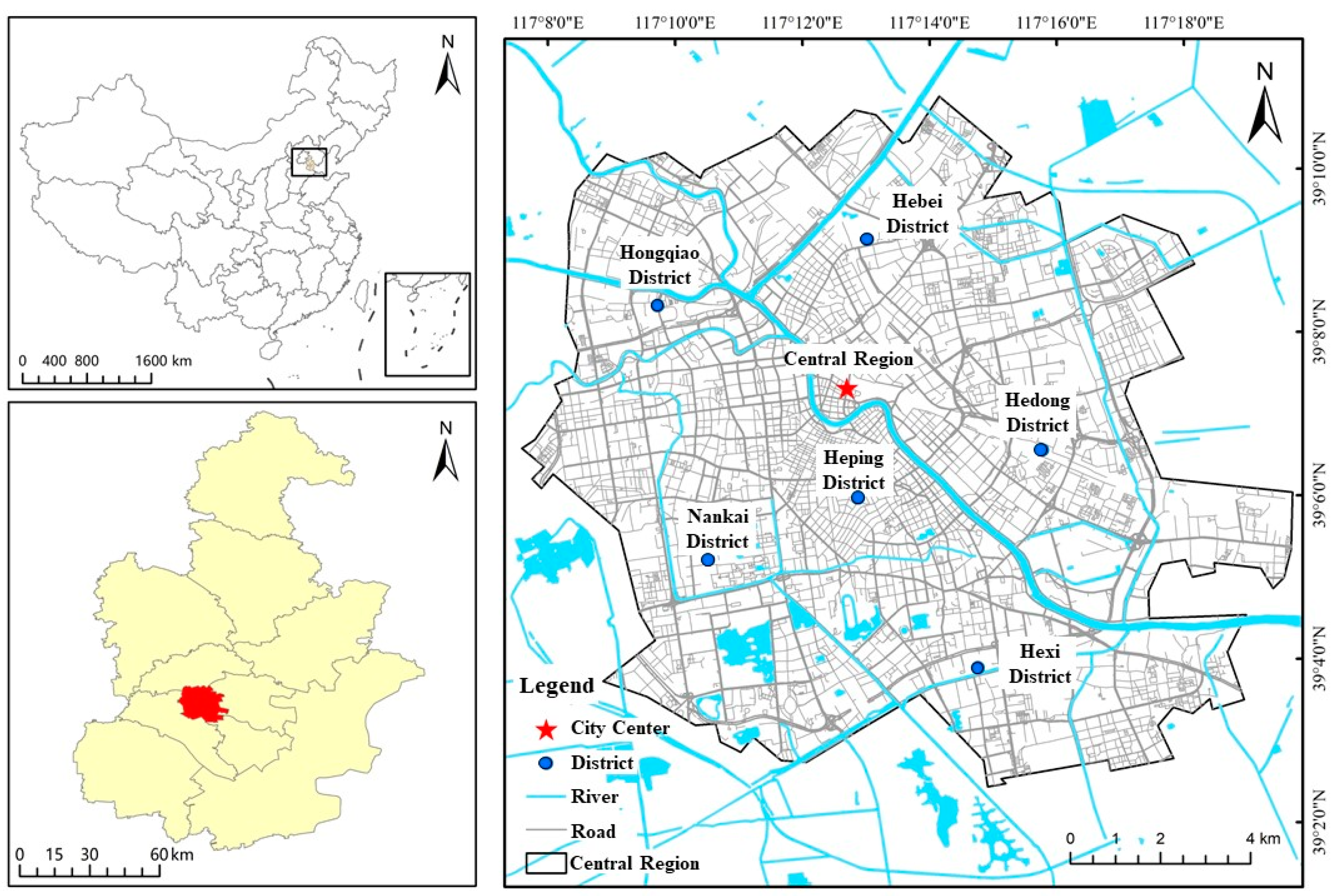
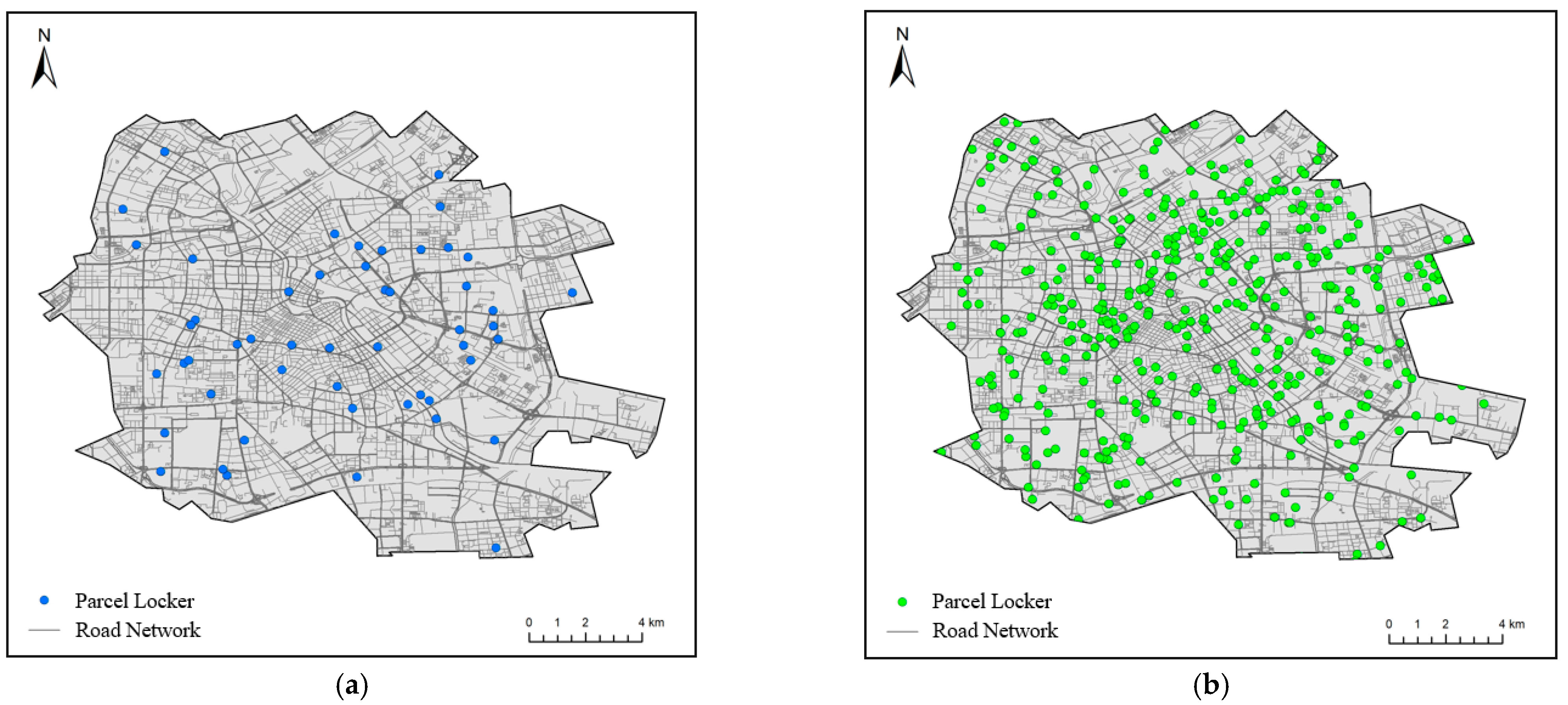
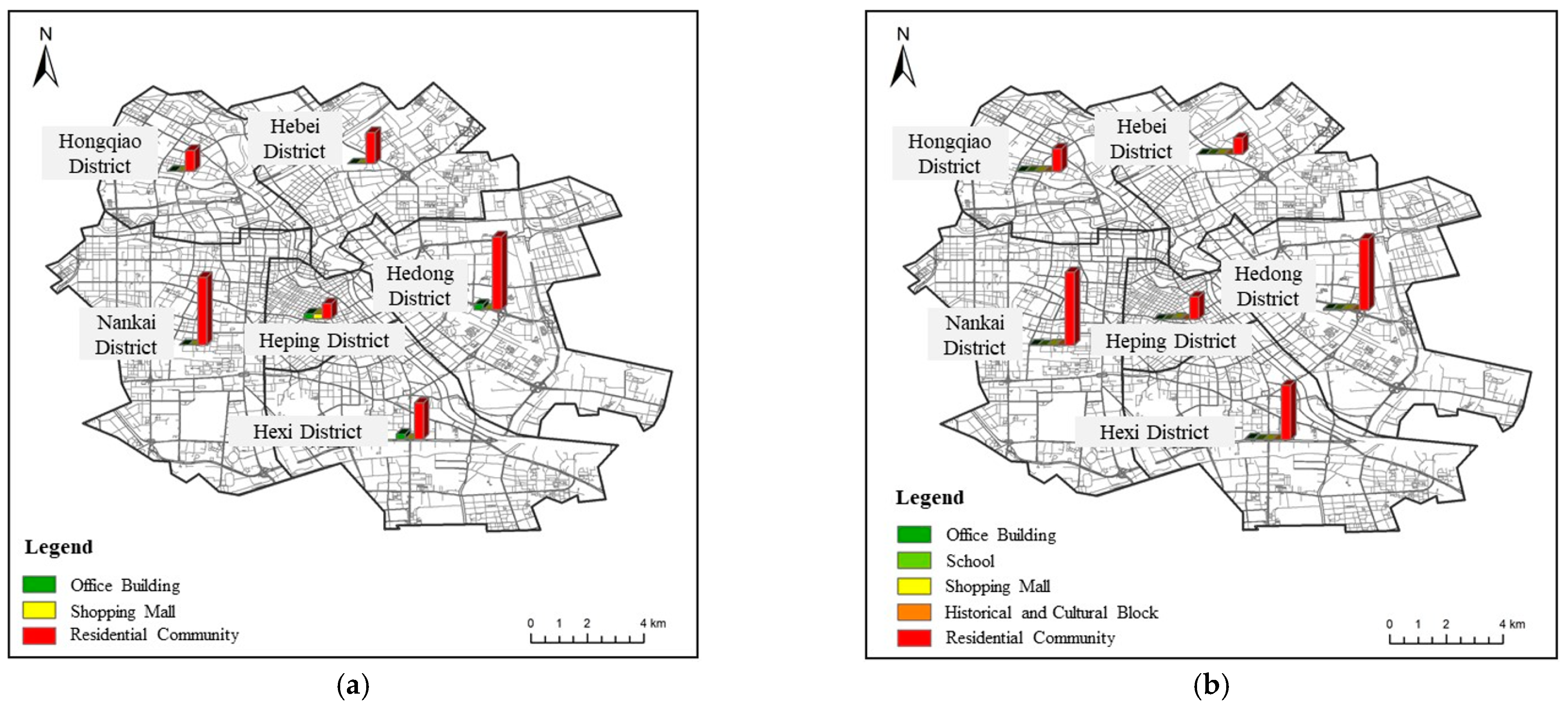
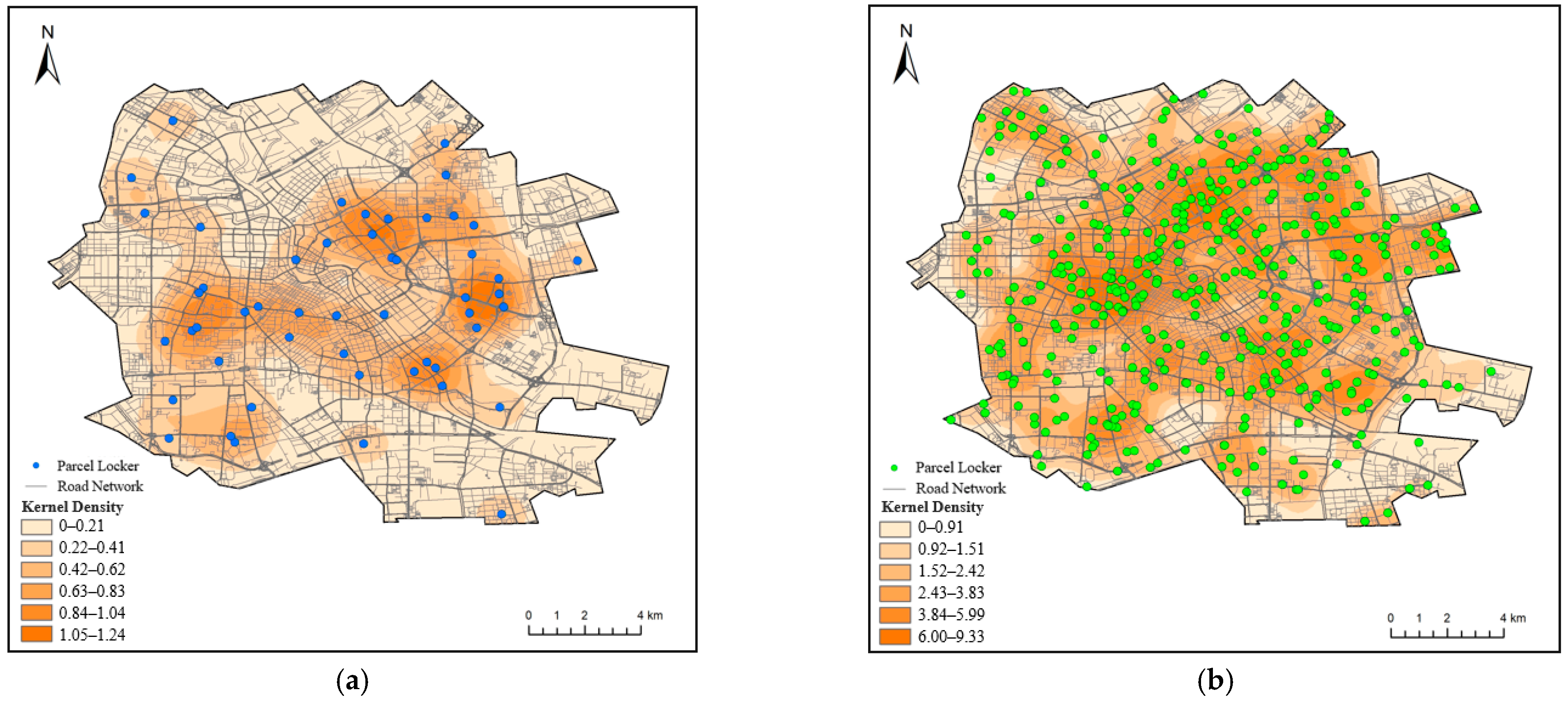
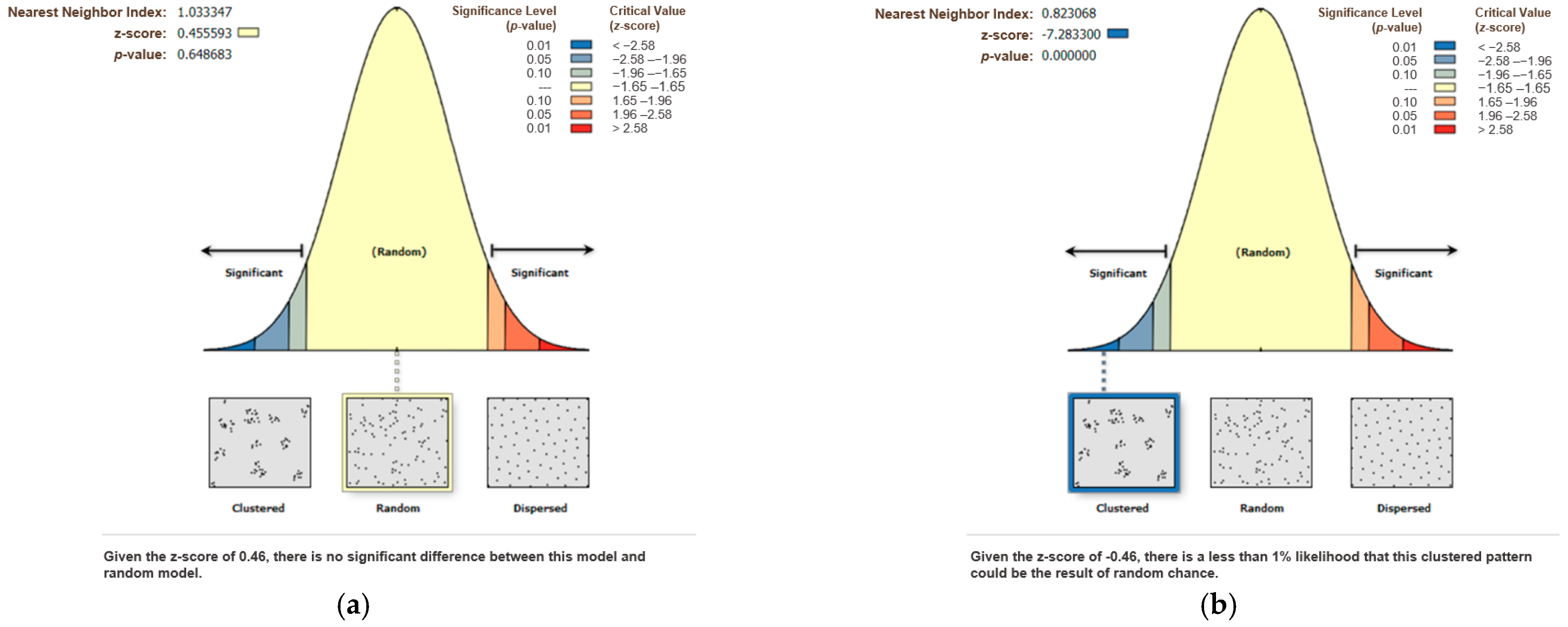
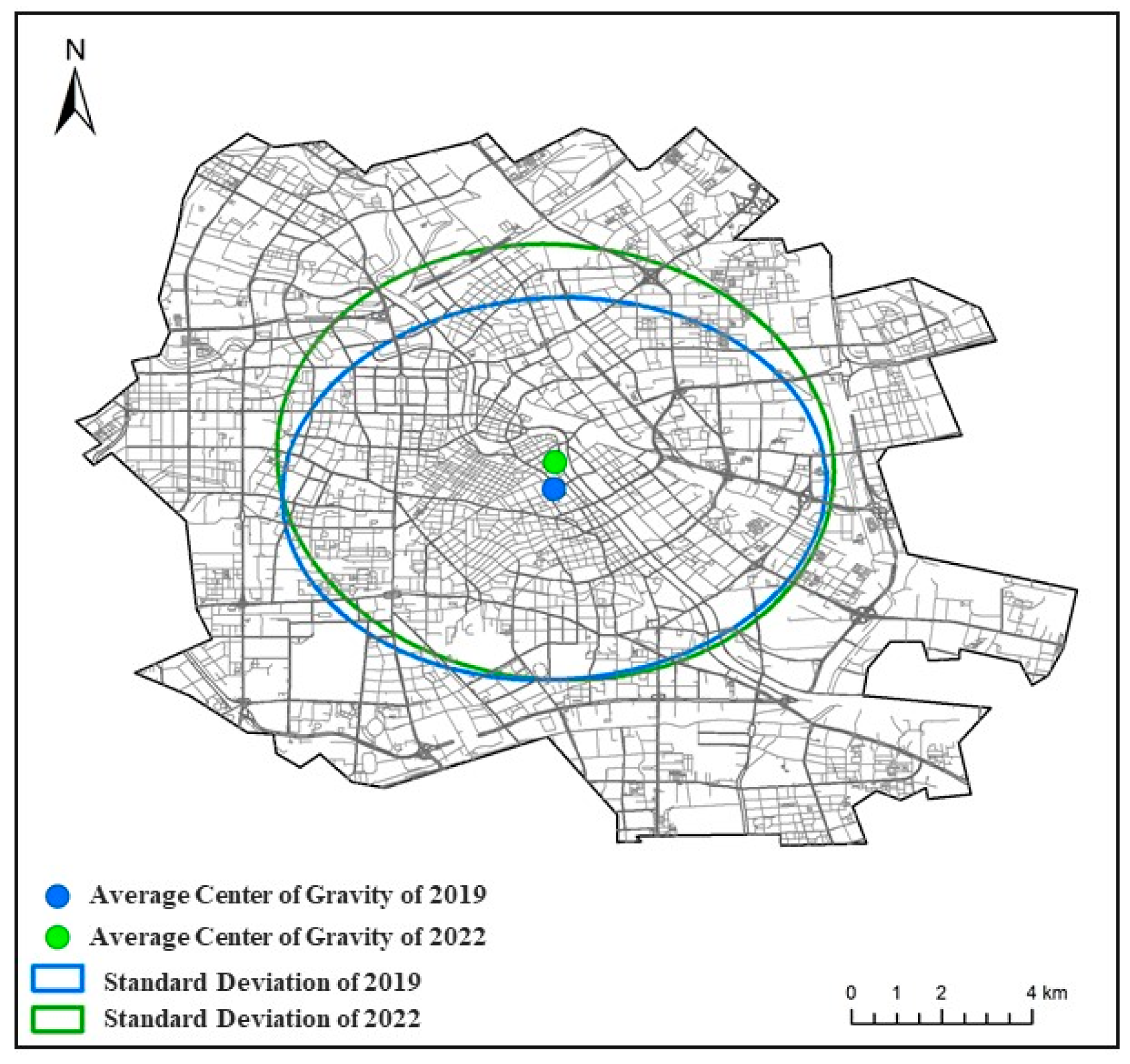
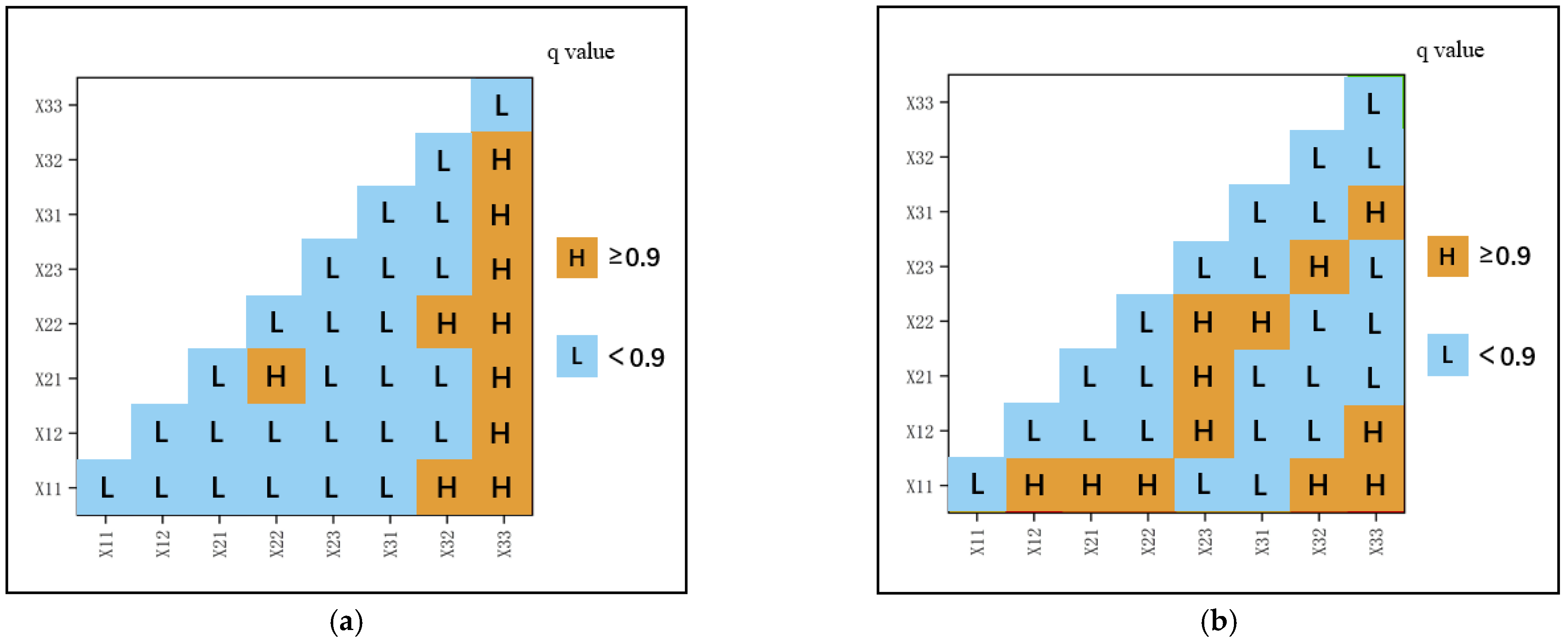
| Factors | Variables | Data Sources |
|---|---|---|
| Urban development (UD, X1) | X11—Total Population | Population Census of Tianjin (2020, 2022) |
| X12—Population Density | Population Census of Tianjin (2020, 2022) | |
| Built environment (BE, X2) | X21—Road Density | OpenStreetMap (OSM), ArcGIS Data and Tianjin City Master Plan (2005–2020) |
| X22—Building Density | OpenStreetMap (OSM) and ArcGIS Data | |
| X23—Residential Community | Lianjia.com (accessed on 19 December 2022) | |
| Personal characteristics (PC, X3) | X31—Gender Ratio | Population Census of Tianjin (2020, 2022) |
| X32—Population Aging | Population Census of Tianjin (2020, 2022) | |
| X33—Per capita income | Population Census of Tianjin (2020, 2022) |
| X11 | X12 | X21 | X22 | X23 | X31 | X32 | X33 | |
|---|---|---|---|---|---|---|---|---|
| X11 | 1.000 | |||||||
| X12 | −0.645 | 1.000 | ||||||
| X21 | −0.420 | 0.793 | 1.000 | |||||
| X22 | −0.363 | 0.707 | 0.842 | 1.000 | ||||
| X23 | 0.586 | 0.223 | 0.268 | 0.230 | 1.000 | |||
| X31 | 0.141 | −0.786 | −0.692 | −0.544 | −0.639 | 1.000 | ||
| X32 | −0.295 | 0.536 | 0.534 | 0.490 | 0.118 | −0.643 | 1.000 | |
| X33 | −0.323 | 0.072 | 0.090 | 0.130 | −0.248 | −0.066 | 0.424 | 1.000 |
| GD Results | Type of Interaction |
|---|---|
| q(X1 ∩ X2) < Min(q(X1), q(X2)) | Nonlinear-weaken |
| Min(q(X1), q(X2)) < q(X1 ∩ X2) < Max(q(X1), q(X2)) 1 | Uni-variable weaken |
| q(X1 ∩ X2) > Max(q(X1), q(X2)) | Bi-variable enhance |
| q(X1 ∩ X2) = q(X1) + q(X2) | Independent |
| q(X1 ∩ X2) > q(X1) + q(X2) | Nonlinear-enhance |
| Year of 2019 | Year of 2022 | ||||
|---|---|---|---|---|---|
| q-Statistic 1 | p-Value | q-Statistic | p-Value | ||
| X1_UD | X11_TP | 0.738 *** | 0.0000 | 0.838 *** | 0.0000 |
| X12_PD | 0.200 ** | 0.0478 | 0.421 *** | 0.0000 | |
| X2_BE | X21_RD | 0.322 ** | 0.0497 | 0.497 ** | 0.0026 |
| X22_BD | 0.364 *** | 0.0035 | 0.651 *** | 0.0000 | |
| X23_RC | 0.279 ** | 0.0119 | 0.398 *** | 0.0000 | |
| X3_PC | X31_GR | 0.200 ** | 0.0478 | 0.444 *** | 0.0000 |
| X32_PA | 0.515 *** | 0.0000 | 0.464 ** | 0.0046 | |
| X33_PI | 0.894 *** | 0.0000 | 0.725 *** | 0.0000 | |
| Bi-Factors | Year of 2019 | Year of 2022 | ||
|---|---|---|---|---|
| Result | Interaction Type 1 | Result | Interaction Type | |
| X11_TP ∩ X12_PD | 0.880 | BE | 1 | BE |
| X11_TP ∩ X21_RD | 0.765 | BE | 0.909 | BE |
| X11_TP ∩ X22_BD | 0.880 | BE | 0.909 | BE |
| X11_TP ∩ X23_RC | 0.880 | BE | 0.843 | BE |
| X11_TP ∩ X31_GD | 0.880 | BE | 0.843 | BE |
| X11_TP ∩ X32_PA | 0.995 | BE | 0.933 | BE |
| X11_TP ∩ X33_PI | 0.976 | BE | 0.999 | BE |
| X12_PD ∩ X21_RD | 0.535 | BE | 0.797 | BE |
| X12_PD ∩ X22_BD | 0.880 | NE | 0.893 | BE |
| X12_PD ∩ X23_RC | 0.492 | BE | 1 | NE |
| X12_PD ∩ X31_GD | 0.492 | NE | 0.850 | BE |
| X12_PD ∩ X32_PA | 0.535 | BE | 0.491 | BE |
| X12_PD ∩ X33_PI | 0.923 | BE | 1 | BE |
| X21_RD ∩ X22_BD | 0.980 | NE | 0.702 | BE |
| X21_RD ∩ X23_RC | 0.612 | BE | 0.909 | BE |
| X21_RD ∩ X31_GD | 0.342 | BE | 0.526 | BE |
| X21_RD ∩ X32_PA | 0.535 | BE | 0.759 | BE |
| X21_RD ∩ X33_PI | 0.923 | BE | 0.793 | BE |
| X22_BD ∩ X23_RC | 0.880 | NE | 0.909 | BE |
| X22_BD ∩ X31_GD | 0.861 | NE | 0.909 | BE |
| X22_BD ∩ X32_PA | 1 | NE | 0.686 | BE |
| X22_BD ∩ X33_PI | 1 | BE | 0.792 | BE |
| X23_RC ∩ X31_GD | 0.492 | BE | 0.843 | BE |
| X23_RC ∩ X32_PA | 0.568 | BE | 0.933 | NE |
| X23_RC ∩ X33_PI | 0.956 | BE | 0.808 | BE |
| X31_GD ∩ X32_PA | 0.612 | BE | 0.784 | BE |
| X31_GD ∩ X33_PI | 1 | BE | 1 | BE |
| X32_PA ∩ X33_PI | 0.916 | BE | 0.793 | BE |
Disclaimer/Publisher’s Note: The statements, opinions and data contained in all publications are solely those of the individual author(s) and contributor(s) and not of MDPI and/or the editor(s). MDPI and/or the editor(s) disclaim responsibility for any injury to people or property resulting from any ideas, methods, instructions or products referred to in the content. |
© 2023 by the authors. Licensee MDPI, Basel, Switzerland. This article is an open access article distributed under the terms and conditions of the Creative Commons Attribution (CC BY) license (https://creativecommons.org/licenses/by/4.0/).
Share and Cite
Ding, M.; Ullah, N.; Grigoryan, S.; Hu, Y.; Song, Y. Variations in the Spatial Distribution of Smart Parcel Lockers in the Central Metropolitan Region of Tianjin, China: A Comparative Analysis before and after COVID-19. ISPRS Int. J. Geo-Inf. 2023, 12, 203. https://doi.org/10.3390/ijgi12050203
Ding M, Ullah N, Grigoryan S, Hu Y, Song Y. Variations in the Spatial Distribution of Smart Parcel Lockers in the Central Metropolitan Region of Tianjin, China: A Comparative Analysis before and after COVID-19. ISPRS International Journal of Geo-Information. 2023; 12(5):203. https://doi.org/10.3390/ijgi12050203
Chicago/Turabian StyleDing, Mengyue, Nadeem Ullah, Sara Grigoryan, Yike Hu, and Yan Song. 2023. "Variations in the Spatial Distribution of Smart Parcel Lockers in the Central Metropolitan Region of Tianjin, China: A Comparative Analysis before and after COVID-19" ISPRS International Journal of Geo-Information 12, no. 5: 203. https://doi.org/10.3390/ijgi12050203
APA StyleDing, M., Ullah, N., Grigoryan, S., Hu, Y., & Song, Y. (2023). Variations in the Spatial Distribution of Smart Parcel Lockers in the Central Metropolitan Region of Tianjin, China: A Comparative Analysis before and after COVID-19. ISPRS International Journal of Geo-Information, 12(5), 203. https://doi.org/10.3390/ijgi12050203








